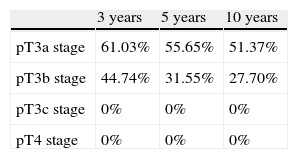To evaluate the prognostic value of venous tumor thrombus in renal cell carcinoma.
Material and methodsA retrospective study of 167 patients with renal cell carcinoma and stage pT3 who underwent radical nephrectomy and extended lymphadenectomy from July 1969 to May 2008 was conducted. Patients with any kind of venous involvement were selected for the analysis (73 patients; 43.7%). The Kaplan–Meier survival curves and log-rank test for comparisons were used for the survival analysis. Multivariate analysis was done by Cox regression.
ResultsLymph node involvement was present in 30 patients (41.1%) and metastatic disease in 9 patients (12.3%). The most frequent histologic renal cell carcinoma subtype was 50 (68.5%) conventional carcinoma, followed by nondifferentiated in 11 (15.5%), and chromophobe in 9 (12.3%). High-grade tumors (Furhman 3–4) were present in 57% of the cases. Venous thrombus level extended to renal vein in 61 patients (83.6%), to inferior vena cava in 9 patients (12.3%) and to the cardiac right atrium in 3 cases (4.1%). The survival analysis showed worse survival in those patients with venous tumor thrombosis (p=0.001) and with vein wall invasion (p=0.0042), but not in function on the level of the thrombus (p=0.12). The multivariate analysis identified the Furhman grade and venous tumor thrombosis as independent survival prognostic factors.
ConclusionsIn our series, venous tumor thrombosis, together with the Furhman nuclear grade, is an independent survival prognostic factor. However, neither cephalic extension of the thrombus nor the invasion of the vein wall showed independent prognostic value.
Analizar el valor pronóstico de la trombosis tumoral venosa en el carcinoma de células renales (CCR).
Material y métodosEstudio retrospectivo de 167 pacientes con carcinoma de células renales (estadio pT3) intervenidos mediante nefrectomía radical y linfadenectomía (julio de 1969 a mayo de 2008). Para el análisis se seleccionaron los pacientes con afectación venosa (73 pacientes; 43,7%). Para el análisis de supervivencia, se utilizaron las curvas de Kaplan-Meyer y el test de log-rank. El análisis multivariante se realizó mediante regresión de Cox.
ResultadosEn 30 pacientes (41,1%) existía afectación ganglionar, y en 9 pacientes (12,3%) enfermedad metastásica. El subtipo histológico más frecuente fue el carcinoma convencional en 50 pacientes (68,5%), seguido del indiferenciado en 11 pacientes (15,5%) y el cromófobo en 9 pacientes (12,3%). El 57% de los tumores fueron de alto grado (Furhman 3-4). El nivel de trombo tumoral se extendía hasta la vena renal en 61 pacientes (83,6%), hasta la cava infradiafragmática en 9 pacientes (12,3%), y en 3 casos (4,1%) al atrio. El análisis de supervivencia mostró peor supervivencia en aquellos pacientes con trombosis tumoral venosa (p=0,001) y con invasión de la pared venosa (p=0,0042) pero no en función del nivel del trombo (p= 0,12). El análisis multivariante identificó el grado de Furhman y la trombosis tumoral venosa como factores pronósticos independientes de supervivencia.
ConclusionesEn nuestra serie la trombosis tumoral venosa es un factor pronóstico independiente de supervivencia, junto al grado nuclear de Furhman. Ni el nivel de extensión cefálica del trombo ni la invasión de la pared venosa mostraron valor pronóstico independiente.











